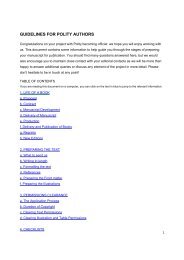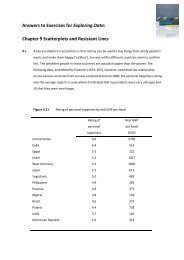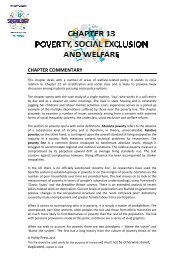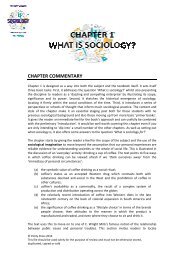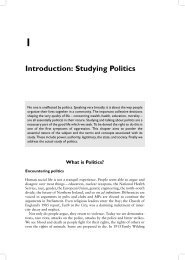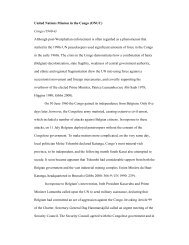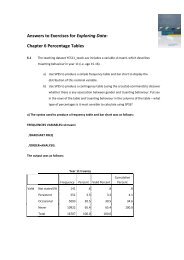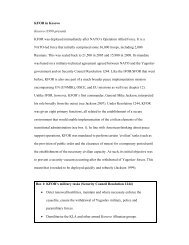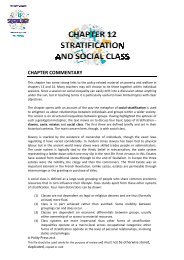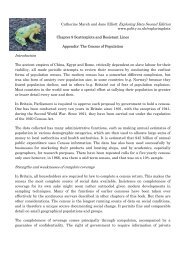Chapter 21 - Crime and Deviance - Polity
Chapter 21 - Crime and Deviance - Polity
Chapter 21 - Crime and Deviance - Polity
Create successful ePaper yourself
Turn your PDF publications into a flip-book with our unique Google optimized e-Paper software.
<strong>Crime</strong> <strong>and</strong> <strong>Deviance</strong><br />
Patterns of crime <strong>and</strong> crime statistics are notoriously difficult to interpret, as not all<br />
crimes are reported, not all reported crimes recorded <strong>and</strong> the basis on which figures are<br />
collated <strong>and</strong> presented are not stable. Using the UK as a case study, it can be said that<br />
from the 1950s to the mid-1990s there was a steady increase both in levels of recorded<br />
crime <strong>and</strong> in public anxiety about crime. Victimization surveys such as the BCS reveal<br />
higher levels of crime than officially gathered statistics but still may under-record crimes<br />
such as domestic violence, which people may be unwilling or fell unable to report. Both<br />
official figures <strong>and</strong> victimization studies recorded from the mid-1990s onward reveal a<br />
general downward trend though levels of anxiety <strong>and</strong> fear of crime do not reflect this<br />
reduction.<br />
The sociology of deviance has tended to concentrate on men, in part reflecting the<br />
lower levels of recorded criminality among women <strong>and</strong> in part the processes of labelling<br />
which are less likely to name female behaviour as deviant. This pattern can be seen as<br />
the outcome of both the processes by which a crime becomes recorded <strong>and</strong> the real<br />
social conditions of women’s lives. Women have fewer opportunities than men to<br />
engage in many criminal activities, as all aspects of their behaviour in the public sphere<br />
remain controlled <strong>and</strong> contained in a way that men’s are not. Women in some<br />
circumstances also escape being labelled as deviant or criminal by evoking the ‘gender<br />
contract’, under which they accept the definition of themselves as erratic <strong>and</strong> in need of<br />
male protection. The extent to which women’s criminal behaviour will change along<br />
with wider changes in their social position remains unclear.<br />
The impact of changing gender patterns in society has also been invoked as an<br />
explanation of apparent increases in male criminality. High levels of male<br />
unemployment produce a crisis for young men in their transition to an adult masculinity.<br />
Criminal behaviour can offer a possible source of adult masculine identity.<br />
The crimes of domestic violence, sexual harassment, sexual assault <strong>and</strong> rape are<br />
overwhelmingly crimes committed by men against women. Only a small proportion of<br />
rapes come to the attention of the authorities, although the number has increased as<br />
police <strong>and</strong> courts have been made more aware of, <strong>and</strong> more sensitive to, these issues.<br />
Rape is not about sexual desire but about violence, power <strong>and</strong> control in a sexualized<br />
way. All women are affected by rape as fear of it limits freedom on the streets <strong>and</strong> can<br />
even create anxiety when home alone. Just as all women are expected to modify their<br />
behaviour, or risk being seen as ‘asking for it’, so too are gay men <strong>and</strong> lesbians who are<br />
publicly open about their sexuality. Youth crime, as Cohen <strong>and</strong> others have argued, is an<br />
area which crystallizes wider social concerns <strong>and</strong> the introduction of Anti-Social<br />
Behaviour Orders (ASBOs) <strong>and</strong> similar initiatives can be seen to criminalize low-level<br />
deviance.<br />
The chapter now turns to consider middle-class crimes, which run counter to popular<br />
perceptions of both crime <strong>and</strong> criminality. White-collar crime covers a range of illegal<br />
activities open to those with professional occupations, notably in the financial sector,<br />
<strong>and</strong> refers to offences which are not sanctioned by companies <strong>and</strong> may harm them, such<br />
as fraud <strong>and</strong> embezzlement. Corporate crime covers all of those harmful activities by<br />
corporations in pursuit of their own interests such as pollution, mislabelling <strong>and</strong><br />
violations of health <strong>and</strong> safety legislation. In these cases, the gap between the<br />
perpetrator <strong>and</strong> the victim of crime is large, but these are not victimless crimes <strong>and</strong> the<br />
victims are often the most vulnerable in society.<br />
185



